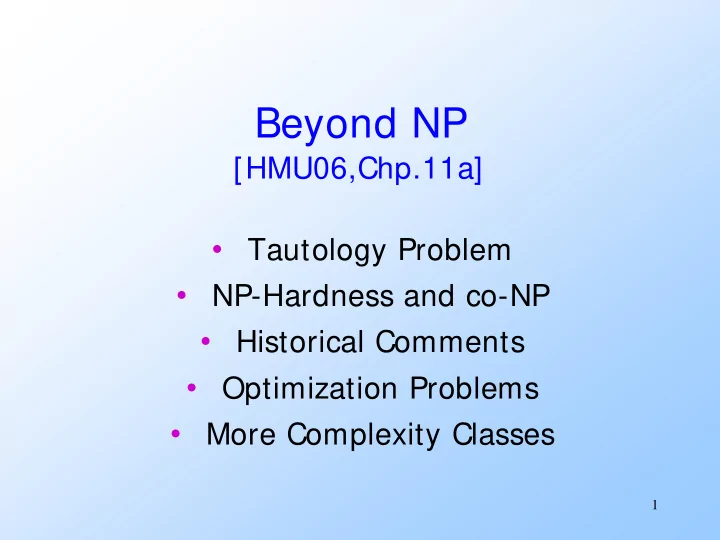

Beyond NP [HMU06,Chp.11a] • Tautology Problem • NP-Hardness and co-NP • Historical Comments • Optimization Problems • More Complexity Classes 1
Tautology Problem & NP-Hardness & co-NP 2
NP-Hardness Another essential part of an NP- completeness proof is showing the problem is in NP . Sometimes, we can only show a problem NP-hard = “if the problem is in P , then P = NP ,” but the problem may not be in NP . 3
Example: NP-Hard Problem The Tautology Problem is: given a Boolean formula, is it satisfied by all truth assignments? Example: x ∨ ¬ x ∨ yz Not obviously in NP , but it’s complement is. Guess a truth assignment; accept if that assignment doesn’t satisfy the formula. 4
Key Point Regarding Tautology An NTM can guess a truth assignment and decide whether formula F is satisfied by that assignment in polytime. But if the NTM accepts when it guesses a satisfying assignment, it will accept F whenever F is in SAT, not Tautology. 5
Co- NP A problem/language whose complement is in NP is said to be in Co-NP NP . Note: P is closed under complementation. Thus, P ⊆ Co- NP . Also, if P = NP , then P = NP = Co- NP . 6
Tautology is NP-Hard While we can’t prove Tautology is in NP , we can prove it is NP-hard. Suppose we had a polytime algorithm for Tautology. Take any Boolean formula F and convert it to ¬ (F). Obviously linear time. 7
Tautology is NP-Hard – (2) F is satisfiable if and only ¬ (F) is not a tautology. Use the hypothetical polytime algorithm for Tautology to test if ¬ (F) is a tautology. Say “yes, F is in SAT” if ¬ (F) is not a tautology and say “no” otherwise. Then SAT would be in P , and P = NP . 8
Historical Comments 9
Historical Comments There were actually two notions of “NP- complete” that differ subtlely. And only if P ≠ NP . Steve Cook, in his 1970 paper, was really concerned with the question “why is Tautology hard?” Remember: theorems are really logical tautologies. 10
History – (2) Cook used “if problem X is in P , then P = NP ” as the definition of “X is NP- hard.” Today called Cook completeness . In 1972, Richard Karp wrote a paper showing many of the key problems in Operations Research to be NP- complete. 11
History – (3) Karp’s paper moved “NP-completeness” from a concept about theorem proving to an essential for any study of algorithms. But Karp used the definition of NP- completeness “exists a polytime reduction,” as we have. Called Karp completeness . 12
Cook Vs. Karp Completeness In practice, there is very little difference. Biggest difference: for Tautology, Cook lets us flip the answer after a polytime reduction. In principle, Cook completeness could be much more powerful, or (if P = NP ) exactly the same. 13
Cook Vs. Karp – (2) But there is one important reason we prefer Karp-completeness. Suppose I had an algorithm for some NP-complete problem that ran in time O(n log n ). A function that is bigger than any polynomial, yet smaller than the exponentials like 2 n . 14
Cook Vs. Karp – (3) If “NP-complete is Karp-completeness, I can conclude that all of NP can be solved in time O(n f(n) ), where f(n) is some function of the form c log k n. Still faster than any exponential, and faster than we have a right to expect. But if I use Cook-completeness, I cannot say anything of this type. 15
Optimization Problems 16
Optimization Problems NP-complete problems are always yes/no questions. In practice, we tend to want to solve optimization problems , where our task is to minimize (or maximize) a parameter subject to some constraints. 17
Example: Optimization Problem People who care about node covers would ask: Given this graph, what is the smallest number of nodes I can pick to form a node cover? If I can solve that problem in polytime, then I can solve the yes/no version. 18
Example – Continued Polytime algorithm: given graph G and budget k, solve the optimization problem for G. If the smallest node cover for G is of size k or less, answer “yes’; otherwise answer “no.” 19
Optimization Problems – (2) Optimization problems are never, strictly speaking, in NP . They are not yes/no. But there is a Cook reduction from the yes/no version to the optimization version. 20
Optimization Problems – (3) That is enough to show that if the optimization version of an NP-complete problem can be solved in polytime, then P = NP . A strong argument that you cannot solve the optimization version of an NP-complete problem in polytime. 21
More Complexity Classes 22
Complexity Zoo There are 100s of complexity classes: P & NP: (non-deterministic) polynomial time (N)EXP: (non-det.) exponential time PSPACE: polynomial space (AI games) RP & ZPP & BPP: probabilistic polynomial BQP: quantum (comp.) polynomial time IP: interactive proofs PCP: probabilistically checkable proofs More: P/poly, co-NP, NL, # P, AC 0 , AM , RP, MA, E , PH, … See Aaronson’s (2000) Complexity Zoo for many more classes and their relation. 23
Recommend
More recommend